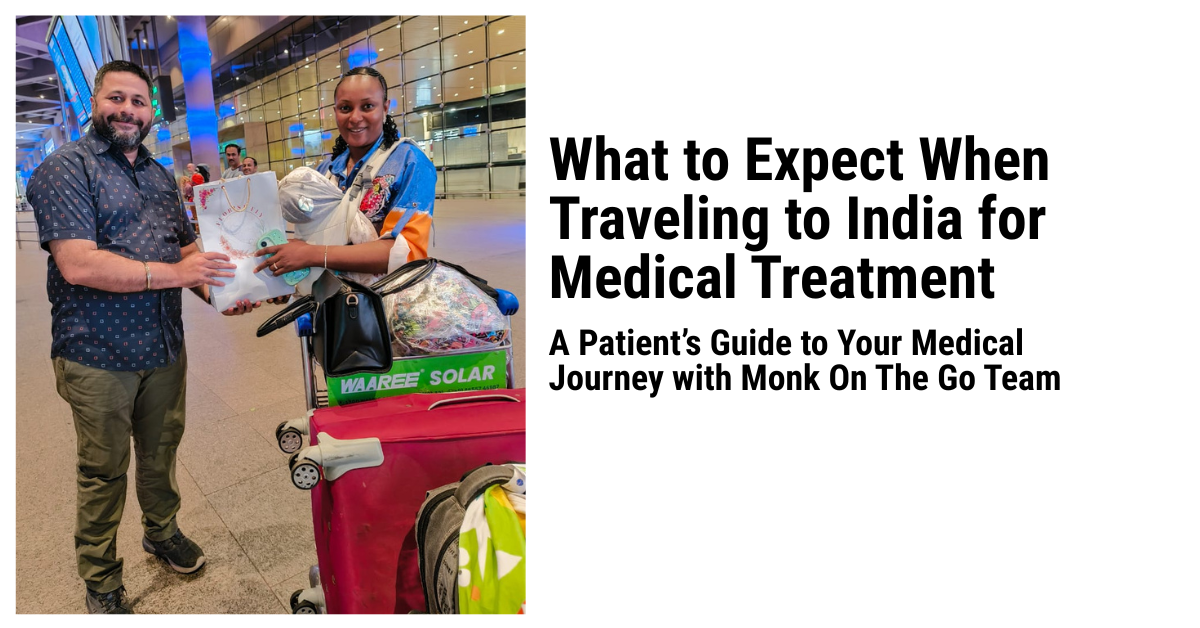
India has become one of the top destinations for international patients seeking affordable, high-quality medical care — especially for treatments like cancer therapy, heart surgery, organ transplants, fertility procedures, and joint replacements. But if you or your loved one are traveling to India for treatment, it’s natural to feel uncertain or anxious.
This guide will help you understand what to expect when you travel with Monk On The Go. Step by step — from landing in India to completing your treatment and flying back home.
1. Before You Travel: Preparing for the Journey
Once your treatment plan is confirmed and you’ve chosen a hospital, here’s what happens before you travel:
- Medical Visa: You’ll need a medical visa to enter India for treatment. We shall send you an “Visa Invitation Letter” that helps speed up the process. Apply for the visa through the nearest Indian embassy or consulate.
- Documents to Carry:
- Valid passport and visa
- Printed medical reports and diagnosis
- Doctor’s notes or referral letters
- Scans, blood reports, etc.
- Proof of funds or sponsor letter
- Emergency contact information
- Vaccinations. You may require Yellow Fever Vaccination if you are traveling from Africa.
- Travel Arrangements: Direct or connecting flights are available to major Indian cities like Delhi, Mumbai, Chennai, Hyderabad, and Bangalore.
2. Arrival and First Impressions
India can feel overwhelming at first — new sights, sounds, and culture. But rest assured, hospitals here are equipped to make international patients feel comfortable.
- Airport Reception: Monk On The Go Team receives you at the airport. The team waits for you with your name on a board (pla-card).
- Accommodation: You may be taken directly to a apartment, hotel, or a hospital-attached patient guest room. Expect basic amenities and Wi-Fi.
- Local SIM Card: You can get a prepaid SIM for your phone at the airport or nearby shop with a passport copy and visa.
- FOREX: You have ample money changing counters at the airport to change your currency to Indian Rupees. If you are too tired to do it after your arrival, the Monk On The Go team can connect you to money changers in your apartment or at the hospital.
3. Hospital Admission and Consultation
Within 1–3 days of arrival, you’ll have your first consultation with the assigned doctor or surgeon.
- Investigations & Confirmations: Indian hospitals will often repeat a few essential tests to reconfirm your diagnosis before starting treatment.
- Language Help: Many hospitals have translators for French, Arabic, Swahili, Russian, and more. Facilitators also help bridge any language gaps.
- Cost Transparency: After all confirmations, the hospital will give a final treatment plan with clear costs. You’ll usually be asked to make a deposit before treatment begins.
4. During Treatment: Care and Support
India is known for its compassionate and well-trained doctors, many of whom have international training.
- Medical Care: Expect high standards — modern equipment, skilled nursing care, strict hygiene protocols, and international treatment guidelines.
- Food & Religion: Hospitals often cater to dietary and religious preferences — vegetarian, Halal, African cuisine, prayer space, etc. Cows are considered sacred in India. Please don’t ask for beef. It’s banned in most parts of India.
- Caregiver Stay: One caregiver is usually allowed to stay with the patient (except in ICUs).
5. After Treatment: Recovery and Follow-Up
- Post-Treatment Stay: Doctors may advise you to stay in India for 2–4 weeks after discharge for recovery, rehab, and follow-ups.
- Daily Checkups: Most hospitals have outpatient departments (OPD) for wound checks, medications, or physiotherapy.
- Medication Support: You’ll be given a proper prescription, a treatment summary, and medicines to carry home. Local pharmacies are affordable and widely available.
6. Returning Home: Final Steps
Before you return:
- Get a fit-to-fly certificate from your doctor.
- Collect discharge summaries, test reports, prescriptions, and aftercare instructions.
- Ensure you know how to contact the hospital or doctor remotely for post-return guidance.
- Monk On The Go helps you with follow-ups over WhatsApp or video calls after you return home.
7. Additional Tips
- Weather: Check the climate of the city you’re visiting — India can be hot and humid, or cool depending on the region.
- Clothing: Carry comfortable, loose-fitting clothes. Hospitals are air-conditioned.
- Currency: Exchange small amounts of cash at the airport. Most major payments can be made via card or bank transfer.
- Cultural Sensitivity: India is diverse and respectful. Modest clothing and polite behavior are appreciated.
Final Thoughts:
Traveling to India for medical treatment may seem like a huge decision, but thousands of patients do it every year — and return home healed and hopeful.
In India, you’re not just a patient. You’re a guest. You’re cared for. And you’re never alone.
Monk On The Go supports your decision with transparent communication, and to make your journey smooth and empowering.
